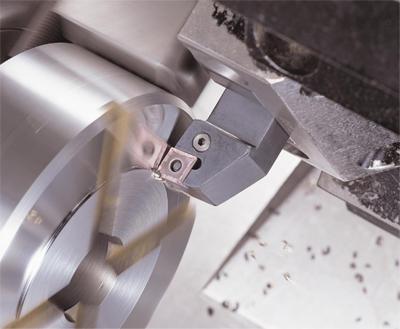
Sumitomo Electric Carbide Inc. has released the new AC6030M and AC6040M turning grades for machining stainless steels.
The AC6030M and AC6040M grades feature Sumitomo's new Absotech grade coating. Absotech coating reportedly improves wear resistance, adhesion resistance and fracture resistance, which extends tool life and, therefore, reduces the cost per part. The AC6030M possesses a new TiB2 surface layer that creates excellent adhesion and chipping resistance. The AC6040M has an optimized Ti and Al composition resulting in superior flank and notch wear resistance.
The AC6030M and AC6040M grades have an expanded chipbreaker lineup highlighted by the newly developed EEM breaker, which enhances chip control when roughing.
Contact Details
Related Glossary Terms
- chipbreaker
chipbreaker
Groove or other tool geometry that breaks chips into small fragments as they come off the workpiece. Designed to prevent chips from becoming so long that they are difficult to control, catch in turning parts and cause safety problems.
- stainless steels
stainless steels
Stainless steels possess high strength, heat resistance, excellent workability and erosion resistance. Four general classes have been developed to cover a range of mechanical and physical properties for particular applications. The four classes are: the austenitic types of the chromium-nickel-manganese 200 series and the chromium-nickel 300 series; the martensitic types of the chromium, hardenable 400 series; the chromium, nonhardenable 400-series ferritic types; and the precipitation-hardening type of chromium-nickel alloys with additional elements that are hardenable by solution treating and aging.
- turning
turning
Workpiece is held in a chuck, mounted on a face plate or secured between centers and rotated while a cutting tool, normally a single-point tool, is fed into it along its periphery or across its end or face. Takes the form of straight turning (cutting along the periphery of the workpiece); taper turning (creating a taper); step turning (turning different-size diameters on the same work); chamfering (beveling an edge or shoulder); facing (cutting on an end); turning threads (usually external but can be internal); roughing (high-volume metal removal); and finishing (final light cuts). Performed on lathes, turning centers, chucking machines, automatic screw machines and similar machines.
- wear resistance
wear resistance
Ability of the tool to withstand stresses that cause it to wear during cutting; an attribute linked to alloy composition, base material, thermal conditions, type of tooling and operation and other variables.






